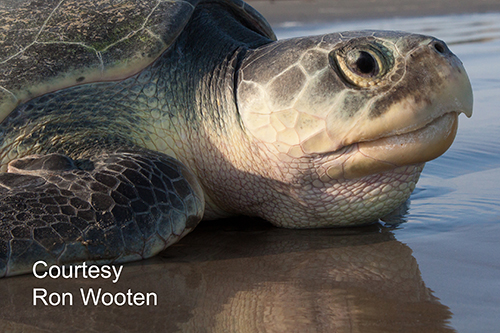 Plans to build a coastal barrier to protect gulf towns from powerful storms in Texas will be harmful for endangered Kemp’s ridley sea turtles.
Plans to build a coastal barrier to protect gulf towns from powerful storms in Texas will be harmful for endangered Kemp’s ridley sea turtles.
Turtle Island Campaign Director, Gulf Coast, Joanie Steinhaus tells us why in an opinion article published in the the Austin American-Statesman.
Austin American-Statesman
The Ike Dike is Not the Solution
OPINION By Joanie Steinhaus – Special to the American-Statesman
Posted: 12:00 a.m. Saturday, June 24, 2017
This spring, I worked with community volunteers to locate and protect the nests of Kemp’s Ridley sea turtles. I got down on my hands and knees, dug out nests and held rare turtle eggs in my hands.
This species of sea turtle almost vanished forever. Due to their incidental capture in fishing gear, a commercial trade, and theft of eggs on nesting beaches, their population plummeted. We were so close to losing them — but through a binational effort this species was saved.
From beach protections to fishing closures, we gave the heart-shaped Kemp’s what it needed for this iconic Gulf species to fight back from the brink of extinction – a true success story.
One thing our endangered Texas sea turtles do not need is a giant coastal wall interfering with their nesting. Sea turtles need our beaches to find places to nest. What will happen to our sandy beaches if the proposed Ike Dike is built? There is a limited amount of sand making it impossible to artificially maintain this structure.
We recognize the real threats associated with sea level rise, storm surges, and hurricanes to our coast.
And we recognize the need for solutions. However, the Ike Dike is not the solution and its legacy in the end will be a project that creates unforeseen environmental and ecological damage and a tax bill for Texans of monumental size.
And that’s why Turtle Island Restoration Network opposes the Ike Dike and urges government officials to explore other options that are most cost-effective, defend the coast, and protect our natural resources.
The Ike Dike, a giant unnatural barrier, will irreparably damage the coast. We will lose habitat for wildlife including endangered sea turtles like the Kemp’s ridley as well as shoreline birds. A giant sea wall will reduce the economic value of recreation activities and impact important tourist dollars.
Contrary to what its supporters are arguing, we believe the Ike Dike will fail to prevent damage from catastrophic events. It is not engineered based on worst-case scenario modeling and will not prevent chemical spills in the Houston Ship Channel. There are approximately 4600 above ground storage tanks, mostly with hazardous materials along the shores of the Houston Ship Channel, and the Ike Dike would not protect these tanks from a storm surge.
We also believe the Ike Dike will permanently change the natural functioning of our bays. Are we ready to face reduced circulation, decreased salinity, and the impediment on fish and shellfish migration? The end result would be decreased shrimp and oyster stocks and the potential destruction of our excellent fishery in the bay system.
Maarten Ruijs at Deft University wrote his thesis on Galveston Bay and stated the following: “The amount and diversity of the living resources in the bay is on its turn dependent on the availability of habitats, water quality and other parameters. Disturbances in the food chain could result in the extinction or abundance of species, considering both flora and fauna”.
We believe that the costs of the Ike Dike have been grossly underestimated, both in terms of construction and ongoing maintenance. How much will it cost to manage and maintain? And who will foot these bills? Texans in the form of increased taxes and special fees.
Turtle Island believes in the need to simultaneously protect wildlife, natural resources, and communities from the risks associated with sea level rise, storm surges, and hurricanes. We believe that there are better and more cost effective ways to meet these needs.
We strongly urge Texans to explore other options to address sea level rise, storm surges, and hurricanes through natural defenses such as the Lone Star Recreation Area and living shorelines.
Joanie Steinhaus, who lives in Galveston, is the Gulf Office Director of Turtle Island Restoration Network.




